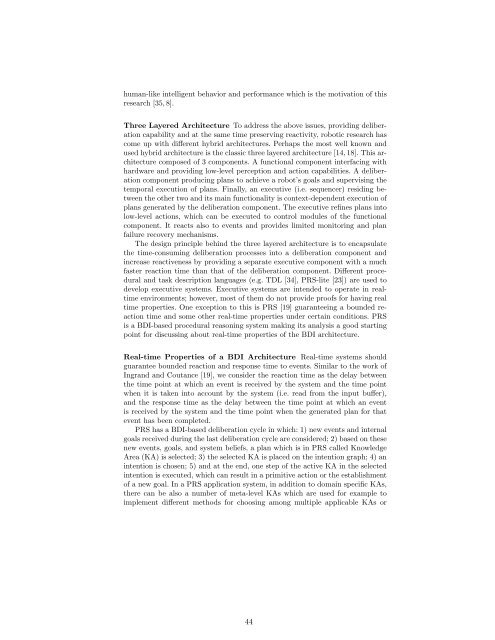Here - Agents Lab - University of Nottingham
Here - Agents Lab - University of Nottingham
Here - Agents Lab - University of Nottingham
Create successful ePaper yourself
Turn your PDF publications into a flip-book with our unique Google optimized e-Paper software.
human-like intelligent behavior and performance which is the motivation <strong>of</strong> thisresearch [35, 8].Three Layered Architecture To address the above issues, providing deliberationcapability and at the same time preserving reactivity, robotic research hascome up with different hybrid architectures. Perhaps the most well known andused hybrid architecture is the classic three layered architecture [14, 18]. This architecturecomposed <strong>of</strong> 3 components. A functional component interfacing withhardware and providing low-level perception and action capabilities. A deliberationcomponent producing plans to achieve a robot’s goals and supervising thetemporal execution <strong>of</strong> plans. Finally, an executive (i.e. sequencer) residing betweenthe other two and its main functionality is context-dependent execution <strong>of</strong>plans generated by the deliberation component. The executive refines plans intolow-level actions, which can be executed to control modules <strong>of</strong> the functionalcomponent. It reacts also to events and provides limited monitoring and planfailure recovery mechanisms.The design principle behind the three layered architecture is to encapsulatethe time-consuming deliberation processes into a deliberation component andincrease reactiveness by providing a separate executive component with a muchfaster reaction time than that <strong>of</strong> the deliberation component. Different proceduraland task description languages (e.g. TDL [34], PRS-lite [23]) are used todevelop executive systems. Executive systems are intended to operate in realtimeenvironments; however, most <strong>of</strong> them do not provide pro<strong>of</strong>s for having realtime properties. One exception to this is PRS [19] guaranteeing a bounded reactiontime and some other real-time properties under certain conditions. PRSis a BDI-based procedural reasoning system making its analysis a good startingpoint for discussing about real-time properties <strong>of</strong> the BDI architecture.Real-time Properties <strong>of</strong> a BDI Architecture Real-time systems shouldguarantee bounded reaction and response time to events. Similar to the work <strong>of</strong>Ingrand and Coutance [19], we consider the reaction time as the delay betweenthe time point at which an event is received by the system and the time pointwhen it is taken into account by the system (i.e. read from the input buffer),and the response time as the delay between the time point at which an eventis received by the system and the time point when the generated plan for thatevent has been completed.PRS has a BDI-based deliberation cycle in which: 1) new events and internalgoals received during the last deliberation cycle are considered; 2) based on thesenew events, goals, and system beliefs, a plan which is in PRS called KnowledgeArea (KA) is selected; 3) the selected KA is placed on the intention graph; 4) anintention is chosen; 5) and at the end, one step <strong>of</strong> the active KA in the selectedintention is executed, which can result in a primitive action or the establishment<strong>of</strong> a new goal. In a PRS application system, in addition to domain specific KAs,there can be also a number <strong>of</strong> meta-level KAs which are used for example toimplement different methods for choosing among multiple applicable KAs or44


